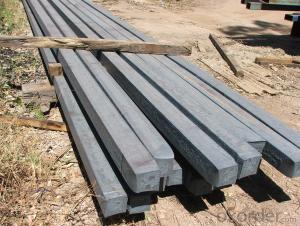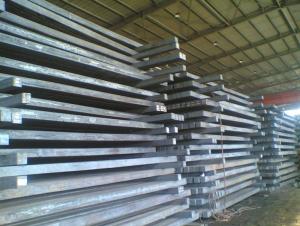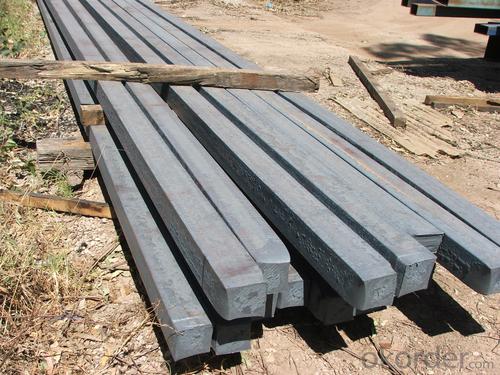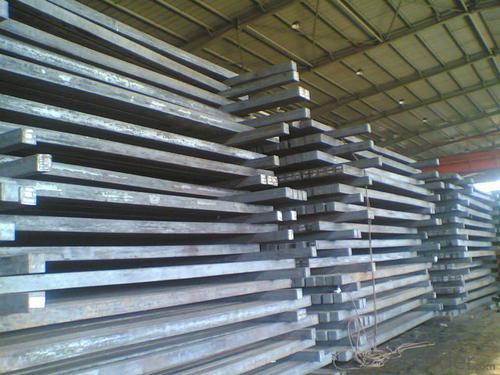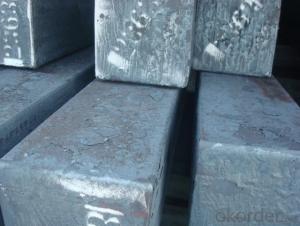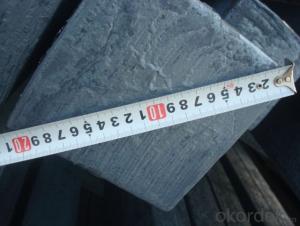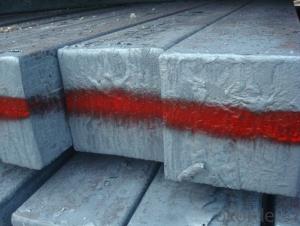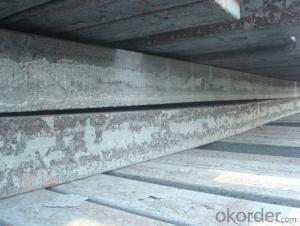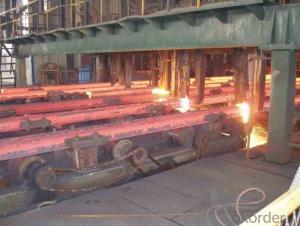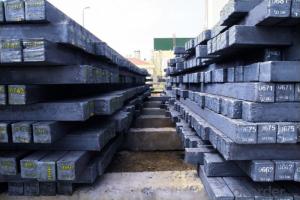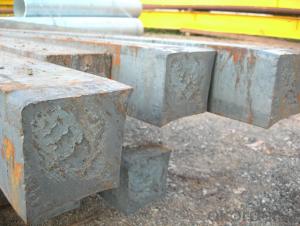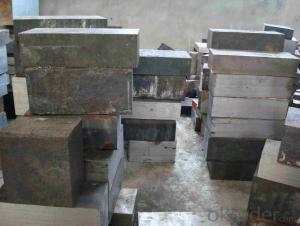Prime quality square alloy steel billet 170mm Q235
- Loading Port:
- Tianjin
- Payment Terms:
- TT OR LC
- Min Order Qty:
- 100 m.t.
- Supply Capability:
- 10000 m.t./month
OKorder Service Pledge
OKorder Financial Service
You Might Also Like
Structure of Prime quality square alloy steel billet 170mm Q235
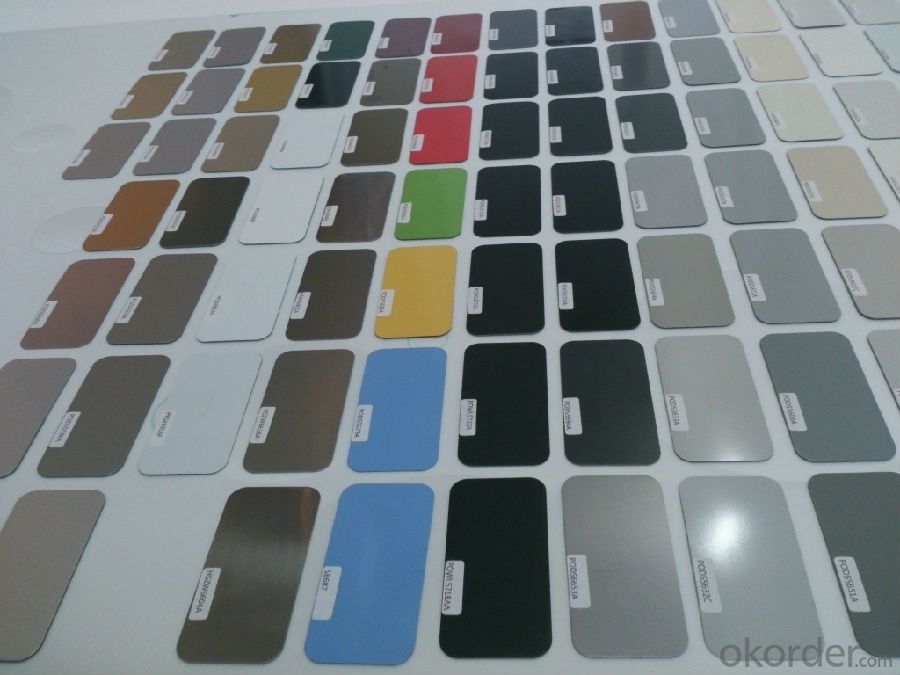
Description of Prime quality square alloy steel billet 170mm Q235
1. Prepainted steel coil is coated with organic layer, which provides higher anti-corrosion property and a longer lifespan than that of galvanized or galvalume steel sheets.
2. The base metals for prepainted steel coil consist of cold rolled, HDGI Steel, electro-galvanized and hot-dip alu-zinc coated steel. The finish coats of prepainted steel coil can be classified into groups as follows: polyester, silicon modified polyesters, polyvinylidene fluoride, high-durability polyester, etc.
3. The production process has evolved from one-coating-and-one-baking to double-coating-and-double-baking, and even three-coating-and-three-baking.
4. The color of the prepainted steel coil has a very wide selection, like orange, cream-colored, dark sky blue, sea blue, bright red, brick red, ivory white, porcelain blue, etc.
5. The prepainted steel coils can also be classified into groups by their surface textures, namely regular prepainted sheets, embossed sheets and printed sheets.

Main Feature of Prime quality square alloy steel billet 170mm Q235
Uncoated CR steel sheet
With the features of in line with the international highest standards in demension and shape, excellent surface finish and properties, the products are mainly used in home appliance and automobile industries.
Galvanized steel sheet(include HDG and EG)
With the features of good corrosion resistance, the products are mainly used in automobile, home appliance, electronics, building and machinery manufacture industries, etc.
Precoated steel sheet
With the features of enviromental protection and good processablility, long lasting surface durability, rich in colors, the products are maily used in building, home appliance and furniture industries, etc.
Applications of Prime quality square alloy steel billet 170mm Q235
Construction
Manufacture anticorrosion, industrial and civil architecture roof boarding, roof grille
Light industries
Home appliance's case, civil chimney, kitchen utensils
Auto industry
Corrosion resistant parts of cars
Agriculture
Food storage, meat and aquatic products' freezing and processing equipment
Commerce
Equipments to store and transport materials, and packing implements

Specifications of Prime quality square alloy steel billet 170mm Q235
Product | Prime quality square alloy steel billet 170mm Q235 |
Material Grade | SGCC / SGCH / DX51D+AZ, etc |
Thickness | 0.6-3.0mm |
Width | 500-1500mm |
Tolerance | Thickness: +/-0.02mm , Width:+/-2mm |
Zinc-coating | Z30-150g/m2 |
Technique | Raw material: Hot rolled steel coil --> Cold rolled_>hot dipped galvalume |
Surface | Dried, Chromated, Unoiled |
Spangle | Regular spangle , small spangle, zero spangle |
ID | 508MM 610MM |
Coil weight | 1-25MT |
Export package | Cardboard inner sleeves, Waterproof paper, galvanized steel covered and steel strip packed |
FAQ of Prime quality square alloy steel billet 170mm Q235
We have organized several common questions for our clients,may help you sincerely:
1. How Can I Visit There?
Our company is located in Tianjin City, China, near Beijing. You can fly to Tianjin Airport Directly. All our clients, from home or aboard, are warmly welcome to visit us!
2. How Can I Get Some Sample?
We are honored to offer you sample.
3. Why choose CNBM?
Our delivery time about 15-20days for standard sizes, if you have other requirements like hardness, quanity and width ,it is about 20-40days. But don't worry we also try our best for the delivery time ,because time longer and our cost is higher.
- Q: How do steel billets contribute to the manufacturing of machinery and equipment?
- Steel billets are a crucial raw material in the manufacturing of machinery and equipment. They serve as the starting point for various processes such as forging, rolling, and machining, where they are transformed into different components and parts. The high strength and durability of steel billets make them ideal for creating robust and reliable machinery, ensuring the final products can withstand heavy loads, harsh environments, and repetitive use. Additionally, the versatility of steel allows for the production of a wide range of machinery and equipment, from small tools to large industrial machinery, making it a vital component in the manufacturing industry.
- Q: What are the main factors affecting the thermal conductivity of steel billets?
- The main factors affecting the thermal conductivity of steel billets include the composition of the steel, its microstructure, temperature, and the presence of impurities or alloying elements.
- Q: What are the common applications of steel billets?
- Steel billets are semi-finished products that are used in various industrial applications. Some of the common applications of steel billets are: 1. Construction: Steel billets are widely used in the construction industry for structural purposes. They are used to manufacture beams, columns, and other load-bearing components in buildings, bridges, and other structures. The high strength and durability of steel billets make them ideal for withstanding heavy loads and providing structural integrity. 2. Automotive Industry: Steel billets are extensively used in the automotive industry for manufacturing various components such as crankshafts, camshafts, connecting rods, and gears. The excellent mechanical properties of steel billets ensure the reliability and performance of these critical automotive parts. 3. Machinery and Equipment Manufacturing: Steel billets are used in the production of machinery and equipment. They are utilized for manufacturing parts like gears, shafts, valves, and hydraulic cylinders. The versatility of steel billets allows for the customization of these components to meet specific operational requirements. 4. Electrical Industry: Steel billets find applications in the electrical industry for the production of electrical transformers and electric motor cores. The high magnetic permeability and electrical conductivity of steel make it an ideal material for these applications. 5. Pipe Manufacturing: Steel billets are commonly used in the manufacturing of pipes and tubes. They are processed through various techniques such as hot rolling, cold rolling, and extrusion to produce seamless or welded pipes. The strength and corrosion resistance of steel billets make them suitable for transporting fluids and gases in industries like oil and gas, water supply, and construction. 6. Shipbuilding: Steel billets are crucial in shipbuilding due to their strength, durability, and resistance to corrosion. They are used to manufacture various ship components such as hulls, frames, and bulkheads. The ability of steel billets to withstand harsh marine environments makes them an ideal choice for constructing ships and offshore structures. Overall, steel billets are versatile materials that find applications in a wide range of industries, thanks to their excellent mechanical properties, durability, and ability to be customized to meet specific requirements.
- Q: How do steel billets compare to other forms of raw steel material?
- Steel billets are a specific form of raw steel material that offer distinct advantages compared to other forms of steel. Firstly, steel billets are known for their high strength and durability. They are produced through a carefully controlled process that ensures a uniform composition and a consistent grain structure, resulting in superior mechanical properties. This makes steel billets ideal for applications that require strong and reliable steel, such as construction, automotive, and manufacturing industries. Furthermore, steel billets offer excellent machinability. Their regular shape and size make them easier to handle and process, reducing wastage and improving efficiency during production. This is particularly beneficial for manufacturers who rely on precision machining techniques to create intricate and complex components. Another advantage of steel billets is their versatility. They can be forged, rolled, or extruded into various shapes and sizes, allowing for customization according to specific requirements. This versatility makes steel billets suitable for a wide range of applications, from structural beams and bars to pipes and rods. Moreover, steel billets have a relatively low carbon content, which makes them more ductile compared to other forms of raw steel material. This increased ductility allows for easier shaping and forming, making steel billets particularly suitable for hot working processes like forging and rolling. In summary, steel billets offer numerous advantages compared to other forms of raw steel material. Their high strength, excellent machinability, versatility, and ductility make them a preferred choice for many industries. Whether it's for structural purposes or manufacturing complex components, steel billets provide the necessary properties and flexibility to meet a wide range of requirements.
- Q: What are the different types of defects that can occur in steel billets?
- There are several types of defects that can occur in steel billets, including surface cracks, internal voids, segregation, inclusions, and dimensional inconsistencies. These defects can affect the quality and structural integrity of the billets and may require further processing or remedial measures to ensure their suitability for use in various applications.
- Q: What are the environmental impacts of manufacturing steel billets?
- The manufacturing of steel billets has several environmental impacts. The process involves significant energy consumption, which often relies on non-renewable sources, leading to high greenhouse gas emissions. Additionally, the extraction and processing of raw materials, such as iron ore and coal, can cause habitat destruction, deforestation, and water pollution. Furthermore, the production of steel billets generates waste and byproducts, including slag and dust, which can have detrimental effects on air and water quality if not properly managed. Overall, the manufacturing of steel billets has notable environmental implications that need to be addressed through sustainable practices and technological advancements.
- Q: How are steel billets used in the manufacturing of mining equipment?
- Steel billets are used in the manufacturing of mining equipment as they serve as the starting material for various components. These billets are first heated and then shaped into desired forms such as gears, shafts, or frames, which are crucial for the construction of heavy-duty mining machinery. The strength and durability of steel make it an ideal choice for withstanding the harsh conditions and rigorous demands of mining operations.
- Q: How are steel billets used in the manufacturing of electrical appliances?
- Steel billets are used in the manufacturing of electrical appliances as a primary raw material for various components, such as casings, frames, and supports. These billets are first heated and then shaped through processes like rolling or extrusion to create the desired parts. The strength, durability, and conductivity of steel make it an ideal material choice for ensuring the structural integrity and efficient functioning of electrical appliances.
- Q: What are the different surface finishing techniques used for steel billets?
- Some of the different surface finishing techniques used for steel billets include shot blasting, pickling, and grinding. Shot blasting involves propelling abrasive particles at high speeds to remove rust, scale, and other surface contaminants. Pickling is a chemical process that uses acids to remove oxides, scale, and other impurities from the surface of the steel billets. Grinding is a mechanical process that uses abrasive wheels to smooth and polish the surface of the billets, creating a desired finish. These techniques help improve the surface quality and prepare the steel billets for further processing or use.
- Q: What are the main differences between hot-rolled and cold-rolled steel billets?
- Hot-rolled and cold-rolled steel billets differ primarily in their manufacturing processes and resulting steel characteristics. To produce hot-rolled steel billets, the steel is heated above its recrystallization temperature, typically around 1200°C (2200°F), and then rolled into the desired shape or size. This involves the use of large-scale machinery, such as rolling mills, which apply significant pressure to shape the steel. Consequently, hot-rolled steel billets have a rough and scaled surface. On the contrary, cold-rolled steel billets are created by further processing the hot-rolled steel. The hot-rolled steel is cooled to room temperature and then passed through a series of rollers at lower temperatures, usually below 1000°C (1832°F). This process offers more precise control over the dimensions and surface finish of the steel. As a result, cold-rolled steel billets exhibit a smoother and more polished appearance compared to their hot-rolled counterparts. Regarding physical and mechanical properties, hot-rolled steel billets generally possess higher yield strength but lower ductility compared to cold-rolled steel. This is due to the hot-rolling process causing strain hardening in the steel, resulting in increased strength but reduced ability to deform without breaking. In contrast, cold-rolled steel retains more ductility as a result of the controlled rolling process at lower temperatures. Another significant distinction lies in the dimensional accuracy of the two steel billet types. Hot-rolled steel billets are known to have larger dimensional tolerances, meaning there can be variations in their thickness, width, and length. Conversely, cold-rolled steel billets possess tighter dimensional tolerances, leading to more precise and consistent dimensions. In summary, the primary differences between hot-rolled and cold-rolled steel billets stem from the manufacturing process, surface finish, physical and mechanical properties, and dimensional accuracy. Understanding these disparities is crucial when selecting the appropriate type of steel billets for specific applications, as each type offers its own advantages and disadvantages.
Send your message to us
Prime quality square alloy steel billet 170mm Q235
- Loading Port:
- Tianjin
- Payment Terms:
- TT OR LC
- Min Order Qty:
- 100 m.t.
- Supply Capability:
- 10000 m.t./month
OKorder Service Pledge
OKorder Financial Service
Similar products
Hot products
Hot Searches
Related keywords
